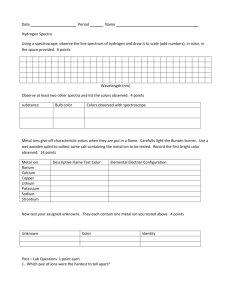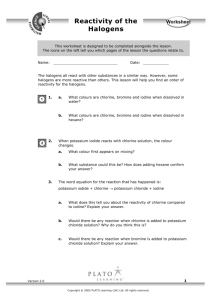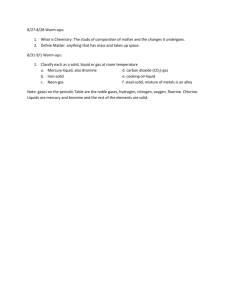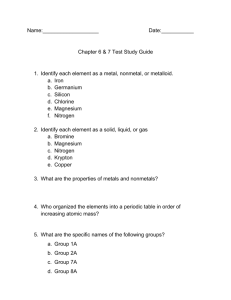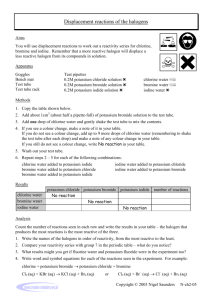The Periodic Table: Properties of Groups
advertisement
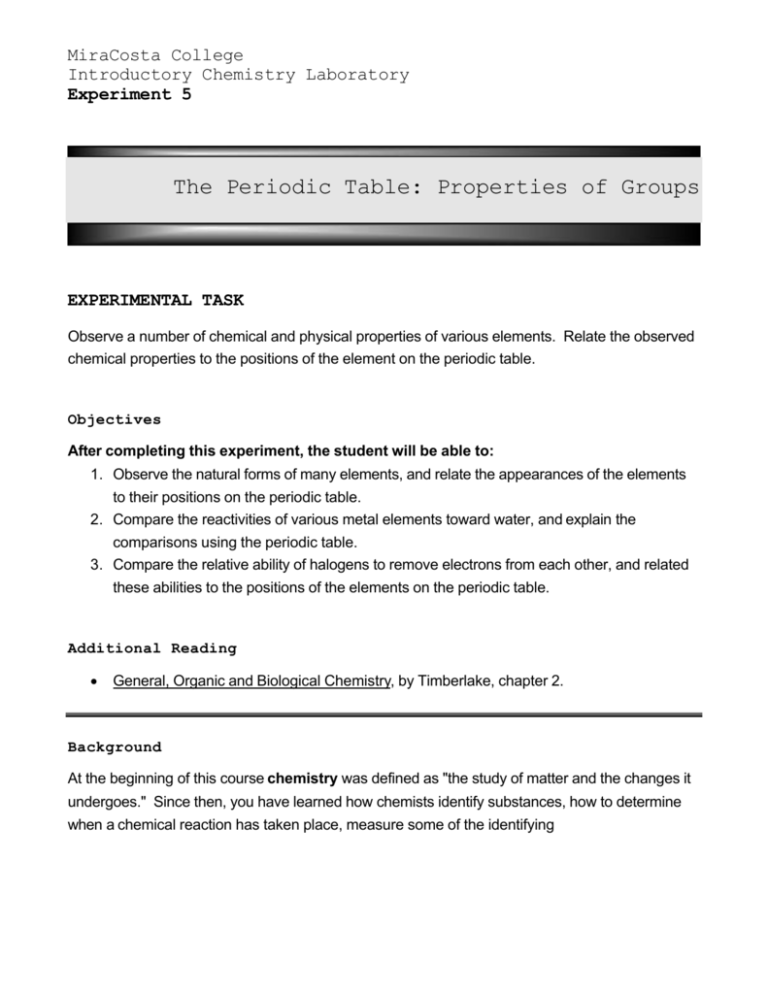
MiraCosta College Introductory Chemistry Laboratory Experiment 5 The Periodic Table: Properties of Groups EXPERIMENTAL TASK Observe a number of chemical and physical properties of various elements. Relate the observed chemical properties to the positions of the element on the periodic table. Objectives After completing this experiment, the student will be able to: 1. Observe the natural forms of many elements, and relate the appearances of the elements to their positions on the periodic table. 2. Compare the reactivities of various metal elements toward water, and explain the comparisons using the periodic table. 3. Compare the relative ability of halogens to remove electrons from each other, and related these abilities to the positions of the elements on the periodic table. Additional Reading • General, Organic and Biological Chemistry, by Timberlake, chapter 2. Background At the beginning of this course chemistry was defined as "the study of matter and the changes it undergoes." Since then, you have learned how chemists identify substances, how to determine when a chemical reaction has taken place, measure some of the identifying CHEM 100 Experiment 5 properties of substances (density, specific heat), etc. All of these are important aspects of doing chemistry, but they don't really explain how and why chemical reactions take place. The fundamental principles that explain many of the properties of the elements are based on the answers to these questions: "Where are the electrons, and what are the electrons doing?" For example, chemical bonding occurs when electrons are shared (covalent bonding) or transferred (ionic bonding, and therefore chemical reactions (which involve the rearrangement of atoms), involve the rearrangement of the electrons used in bonding. In this experiment you will explore chemical and physical properties of elements, and relate the similarities and differences between elements to the relative positions of the elements on the periodic table. In Part A you will simply observe samples of many elements, and record your observations. In Part B you will compare the reactivity toward water of 4 main group metal elements. In Part C you will compare the relative ability of halogen (group 7A) non-metal elements to remove electrons from each other. You will not need a separate section in Results for part A, as the observations of the elements you record in the Experimental Procedure section will be sufficient. The final result for each chemical reaction in parts B and C will be brief statements describing: 1) the appearance of each reactant before mixing; 2) the appearance of each mixture after the reactants have been mixed; and 3) a statement as to whether a chemical reaction occurred or not. Pre-lab Questions 1. Identify each of these properties as generally being either a physical property or a chemical property: A. Hydrogen burns in oxygen to give gaseous water. B. Pure solid iron has a dull gray surface. C. A clear, light green solution of iron(II) chloride in water turns yellow when mixed with a clear, colorless solution of sodium hypochlorite. 2. Give the name and group number for each of these elements: A. Ge B. Te C. Rb D. Be Copyright 2 2004 by Mark A. Yeager CHEM 100 Experiment 5 3. Give the symbol and period number for each of these elements: A. Chlorine B. Strontium C. Carbon D. Platinum BEFORE STARTING THE EXPERIMENT Safety Always keep in mind the rules presented in both the "MCC Laboratory Safety Rules" and the Laboratory Handbook for General Chemistry. It is your responsibility to make sure that you follow all safety rules at all times, and to graciously help everybody else in the laboratory (including the instructor) to do the same. Hazardous Materials Part A—Appearance of the Elements: Do not open any of the containers!! Some of these elements are highly toxic (bromine, lead, and germanium). Some are corrosive and/or highly reactive and therefore strong irritants (lithium, sodium, potassium, calcium, iodine). Part B—Reactions of Metal Elements with Water: Be very careful in handling the metal elements, as some of them are highly reactive--wear gloves, and follow the directions carefully, using no more than the described amount of each. Part C—Reactions of Neutral Halogens with Halide Ions: Chlorine water and bromine water are both corrosive and toxic, and can produce small amounts of toxic gas--wear gloves while handling them, and avoid breathing their vapors. Hexane is flammable, so no flames will be allowed in the laboratory. ALL WASTES MUST BE DISCARDED IN THE APPROPRIATE WASTE CONTAINERS, AS DIRECTED BY THE INSTRUCTOR. 3 Copyright 2004 by Mark A. Yeager CHEM 100 Experiment 5 EXPERIMENT PROCEDURE Part A—Appearance of the Elements Bring one of the sets of elements to your lab bench. (Note: Each set contains only some of the elements--do not take more than one set to your bench at a time.) Observe the appearance of the elements, and record your detailed observations of each element. Part B—Reactions of Metal Elements with Water Label a 50-mL beaker, "sodium + water." Put about 15 mL of water into the beaker. Obtain a couple strips each of red and blue litmus paper. Obtain a small circle of filter paper (or tear a larger circle into halves). Label the piece of filter paper, "sodium." Put on your gloves, take the piece of filter paper to the instructor’s desk, and (very nicely) ask the instructor to provide a small piece of sodium metal. The instructor will place the piece of metal on the piece of filter paper--use the filter paper to absorb the liquid that covers the metal, and keep the filter paper wrapped around the metal. Take the filter paper and metal piece back to your lab bench. Record your observations of the element. Carefully add the piece of sodium to the water in the beaker labeled, "sodium + water," and observe what happens. Once the reaction (if any) stops, test the water solution with both red and blue litmus paper (remember that red litmus turns blue in base, and blue litmus turns red in acid). To do this, carefully dip just the tip of the litmus paper strip in the liquid being tested, then place the strip on a watch glass. Repeat the entire process for potassium. After you have finished with sodium and potassium, obtain one or two pieces each of calcium and magnesium from the reagent cart (use a separate, labeled beaker for each element). Follow the procedure used for potassium and sodium in adding each element to water, and then testing the mixture with litmus paper. Dispose of all waste from Part B in the “Liquid Organic Waste” container, except for the filter paper and the litmus paper, which must be put into the “Dry Waste” container. 4 Copyright 2004 by Mark A. Yeager CHEM 100 Experiment 5 Part C: Reactions of Neutral Halogens with Halide Ions Label three small test tubes as follows: 1. chlorine water and hexane CONTROL 2. bromine water and hexane CONTROL 3. iodine water and hexane CONTROL Add 5 drops of chlorine water to test tube 1, 5 drops of bromine water to test tube 2, and 5 drops of iodine water to test tube 3. Next, add 10 drops of hexane to EACH test tube. Record your observations of the hexane layer (the top layer). These test tubes show the color of each element as it will appear in the hexane layer, and will therefore help you identify which element is present after mixing the solutions as given below. Label six small test tubes as follows: 1. chlorine water + potassium bromide (KBr) 2. chlorine water + potassium iodide (KI) 3. bromine water + potassium chloride (KCl) 4. bromine water + potassium iodide (KI) 5. iodine water + potassium chloride (KCl) 6. iodine water + potassium bromide (KBr)". Begin by putting about 1 mL of the given “potassium xxxxide” solution into each test tube—that is, for test tube 1, use potassium bromide solution, for test tube 2 use potassium iodide solution, etc.. Record your observations of these solutions. Then, add 5 drops of either chlorine water, bromine water, or iodine water, as shown for that test tube—for test tubes 1 and 2, use chlorine water, for test tubes 3 and 4, use bromine water, and for test tubes 5 and 6, use iodine water. Record your observations. Finally, add about 10 drops of hexane (caution--flammable) to each test tube, tightly stopper the test tube, and gently shake it for a few seconds, but REMOVE the stopper immediately after shaking. Let the hexane and water separate (the top layer will be hexane), and record your observations (any halogens--chlorine, bromine or iodine--in the water solution will be drawn into the hexane, which will help to intensify the color of the halogen). Compare the color of the hexane layers in these 6 test tubes to those in the control test tubes to identify which element--chlorine, bromine or iodine--is present in the hexane layer after mixing. Put all of the waste from Part C in the “Organic Hazardous Waste” container. 5 Copyright 2004 by Mark A. Yeager CHEM 100 Experiment 5 Clean-up: Dispose of all wastes in the appropriate waste containers (liquids in ‘liquid waste,’ solids and paper in ‘dry waste,’ etc.). Wash all containers and utensils with soap and water, rinse with tap water and then with DI water, and then dry with paper towel. RESULTS Part A: Appearance of the Elements: No Results section needed. Parts B and C: Reactions of the Elements: In each part, create a table that summarizes the observations that indicate whether or not a reaction took place. These tables should include the appearance of each reactant before mixing, and the appearance of the mixture after mixing, and should follow the formats given here. Part B Table: Reaction: Appearance of metal before mixing Description of reaction Final appearance (if any) of mixture Sodium + water Potassium + water Magnesium + water Calcium + water 6 Copyright 2004 by Mark A. Yeager CHEM 100 Experiment 5 Part C Table: Potassium chloride Potassium bromide Potassium iodide Chlorine water Bromine water Iodine water DISCUSSION Part A: Appearance of the Elements: Note and discuss any similarities between elements and explain how these similarities relate to the elements’ positions on the periodic table. Are all of the shiny elements from the same part of the periodic table? Etc. Parts B: Reactions of Metal Elements with Water: Atoms of metal elements, in general, give up electrons easily. In Part B, each element was added to water. If a reaction occurred, atoms of the neutral metal element lost electrons to the water. Those metals that reacted most strongly with water are the elements that give up their electrons most easily. Which metal reacted most vigorously? Did any not react? Was the vigor of the reactions most similar between elements in the same period, or between elements in the same group? Parts C: Reactions of Neutral Halogens with Halide Ions: Atoms of non-metal elements, in general, gain electrons easily. Neutral halogen elements exist normally as molecules made up of two atoms. For instance, the normal form of the element chlorine is the Cl2 molecule, where two atoms of chlorine are bonded together. These halogen molecules tend to grab electrons from other sources, such as metal atoms, to produce 7 Copyright 2004 by Mark A. Yeager CHEM 100 Experiment 5 halogen atoms that have one extra electron each. This extra electron gives the atom a –1 charge. Any atom that has an electrical charge on it is called an ion. The ions made from halogen elements are called halides. Neutral halogens are all colored—chlorine is a greenish-yellow gas, bromine is a dark reddishbrown liquid, and iodine is a dark purple solid. However, the negative ions of these elements, the halides, are all colorless. So, in part C you were testing to see which neutral halogens are capable of pulling an electron away from another halogen’s halide ion. For example, when the pale greenish-yellow solution of chlorine water is mixed with the colorless solution of potassium bromide, if there is a color change it means that a reaction took place in which neutral chlorine molecules (greenish-yellow) were able to remove electrons from the negative bromide ions (colorless) to give negative chloride ions (colorless) and neutral bromine molecules (reddish-orange). If the reaction did take place, it shows that the halogen (Cl) is able to remove an electron from halide ion (Br–), indicating that chlorine holds onto electrons more strongly than bromine. If no reaction takes place, it means that bromine holds onto electrons more strongly than chlorine. 8 Copyright 2004 by Mark A. Yeager



